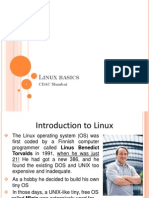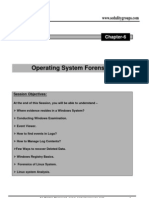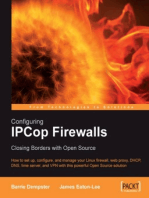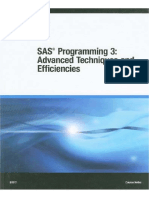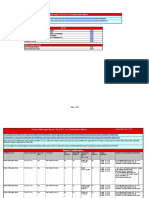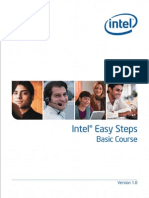100%(1)100% found this document useful (1 vote)
557 viewsBooting Power Point Presentation
Booting Power Point Presentation
Uploaded by
Harsh PatelThe document discusses the boot process and power-on self-test (POST) in computers. It explains that booting loads the operating system when a computer is turned on. The boot process begins with POST which tests hardware components like memory, I/O buses, and displays error codes. It then describes the roles of the BIOS, boot loader, and how different devices can be used for booting. POST sequences for various systems like IBM, Mac, and Amiga are also outlined.
Copyright:
Attribution Non-Commercial (BY-NC)
Available Formats
Download as PPT, PDF, TXT or read online from Scribd
Booting Power Point Presentation
Booting Power Point Presentation
Uploaded by
Harsh Patel100%(1)100% found this document useful (1 vote)
557 views16 pagesThe document discusses the boot process and power-on self-test (POST) in computers. It explains that booting loads the operating system when a computer is turned on. The boot process begins with POST which tests hardware components like memory, I/O buses, and displays error codes. It then describes the roles of the BIOS, boot loader, and how different devices can be used for booting. POST sequences for various systems like IBM, Mac, and Amiga are also outlined.
Copyright
© Attribution Non-Commercial (BY-NC)
Available Formats
PPT, PDF, TXT or read online from Scribd
Share this document
Did you find this document useful?
Is this content inappropriate?
The document discusses the boot process and power-on self-test (POST) in computers. It explains that booting loads the operating system when a computer is turned on. The boot process begins with POST which tests hardware components like memory, I/O buses, and displays error codes. It then describes the roles of the BIOS, boot loader, and how different devices can be used for booting. POST sequences for various systems like IBM, Mac, and Amiga are also outlined.
Copyright:
Attribution Non-Commercial (BY-NC)
Available Formats
Download as PPT, PDF, TXT or read online from Scribd
Download as ppt, pdf, or txt
100%(1)100% found this document useful (1 vote)
557 views16 pagesBooting Power Point Presentation
Booting Power Point Presentation
Uploaded by
Harsh PatelThe document discusses the boot process and power-on self-test (POST) in computers. It explains that booting loads the operating system when a computer is turned on. The boot process begins with POST which tests hardware components like memory, I/O buses, and displays error codes. It then describes the roles of the BIOS, boot loader, and how different devices can be used for booting. POST sequences for various systems like IBM, Mac, and Amiga are also outlined.
Copyright:
Attribution Non-Commercial (BY-NC)
Available Formats
Download as PPT, PDF, TXT or read online from Scribd
Download as ppt, pdf, or txt
You are on page 1of 16
Prepared By : HARSH PATEL
In computing, booting (also known as "booting up")
is a bootstrapping process that starts
operating systems when the user turns on a
computer system.
A boot sequence is the initial set of operations that
the computer performs when power is switched on.
The boot loader typically loads the main
operating system for the computer.
The computer word boot is short for 'bootstrap' .
In computers in the 1950s, pressing a bootstrap
button caused a hardwired program to read a
bootstrap program.
Thebootstrap concept was used in the IBM 701
computer (1952-1956) .
The small program that starts this sequence of loading into
RAM, is known as a bootstrap loader, bootstrap or boot
loader.
This small boot loader program's only job is to load other
data and programs which are then executed from RAM.
In BOOT process first POST takes place.
Commonly, the Booting process has 12 Working steps for
various operating Systems(This procedure may differ
slightly for Mac, UNIX, OS/2, or other operating systems.)
The small program that starts this sequence of loading into
RAM, is known as a bootstrap loader, bootstrap or boot
loader.
Second-stage boot loader: GRUB, BOOTMGR, LILO
or NTLDR
Network booting: Most computers are also capable of
booting over a computer network. In this scenario, the
operating system is stored on the disk of a server, and certain
parts of it are transferred to the client using a simple protocol
such as the Trivial File Transfer Protocol
The boot device is the device from which the operating
system is loaded.
A modern PC BIOS supports booting from various
devices, typically a local hard disk drive ,an
optical disc drive, a USB device , or a network interface
card (using PXE).
Older, less common bootable devices include
floppy disk drives, SCSI devices, Zip drives, and LS-120
drives.
Other kinds of Boot sequences: Some modern CPUs
and microcontrollers may have boot ROM with boot code
integrated directly into their silicon, so they could perform quite
sophisticated boot sequence on its own and load boot programs
from various sources like NAND flash, SD or MMC card.
It is also possible to take control over a system by using a
hardware debug interface such as JTAG
Most digital signal processors have the following boot
modes:
Serial mode boot
Parallel mode boot
In IBM mainframe systems, the boot process is known as
IPL (Initial Program Load).
The term was coined by IBM for the design of the
System/360 and continues to be used in those
environments today
In systems that share the System/360 heritage—and in
some that have been inspired by it, including smaller
systems such as the IBM 1130—IPL is a hardware
function, not a program run on the system itself.
Hard Reboot : A hard reboot (also known as a cold reboot, cold
boot or cold start) is when power to a computer is cycled (turned off and
then on) or a special reset signal to the processor is triggered. This
restarts the computer without first performing any shut-down procedure
Soft reboot :A soft reboot (also known as a warm reboot) is
restarting a computer under software control, without removing
power or (directly) triggering a reset line.
Random reboot :Random reboot is a non-technical term referring
to an unintended (and often undesired) reboot for which the cause is not
immediately evident to the user. Such reboots may occur due to a
multitude of software and hardware problems, such as triple faults.
Power-on self-test (POST) is the common term
for a computer.
It is the first step of the more general process
called BOOTING.
Systems Power-on self-test (POST) refers to the
testing sequence that occurs when a system is
first powered on.
Test the power supply to ensure that it is turned on
CPU must exit the reset status mode to be able to
execute instructions
BIOS & CMOS checksum must be valid, meaning
that it must be readable.
CPU must be able to read all forms of memory
The first 64KB of memory must be operational and
have the capability to be read and write.
I/O bus / controller must be accessible and able to
write / read from the video subsystem
The principal duties of the main BIOS during POST are as
follows:
verify the integrity of the BIOS code itself
find, size, and verify system main memory
discover, initialize, and catalog all system buses and devices
pass control to other specialized BIOS (if and when required)
provide a user interface for system's configuration
identify, organize, and select which devices are available for
booting
construct whatever system environment that is required by the
target OS
Original IBM POST beep codes
POST AMI BIOS beep codes
POST beep codes on A+ Hardware Core exam
IBM POST diagnostic code descriptions
Apple's Macintosh computers also perform a POST
after a cold boot. In the event of a fatal error, the
Mac will not make its startup chime.
Old World Macs (until 1998)
New World Macs (1998-1999)
New World Macs (1999 onward) and Intel-based
Macs
POST Sequence of Amiga
Sequence for all main Amiga models
Amiga Color Screens Scheme
16.4 - Correct Tests Color Sequence Scheme
Failed Tests Color Scheme
Amiga Keyboard LED error signals
Thank You
You might also like
- Sample Final Exam EECS388 - Fall 2020Document19 pagesSample Final Exam EECS388 - Fall 2020Jeren ChenNo ratings yet
- Firewall Design PrinciplesDocument19 pagesFirewall Design PrinciplesmiphyNo ratings yet
- Database Security and Privacy UNIT - I - PPTDocument62 pagesDatabase Security and Privacy UNIT - I - PPTVathana Dennish100% (1)
- 01 - Computer Forensics FundamentalsDocument6 pages01 - Computer Forensics FundamentalsKranthi Kumar ChNo ratings yet
- Connectivity Guide For IBM InfoSphere Classic Federation Server For z/OSDocument70 pagesConnectivity Guide For IBM InfoSphere Classic Federation Server For z/OSRoshava KratunaNo ratings yet
- Cryptography Intruders in Network SecurityDocument11 pagesCryptography Intruders in Network SecurityShem KiprutoNo ratings yet
- SCI4201 Lecture 8 - Macintosh and Linux Boot Processes and File SystemsDocument23 pagesSCI4201 Lecture 8 - Macintosh and Linux Boot Processes and File Systemsonele mabhenaNo ratings yet
- Digital and Mobile Forensics Laboratory - Experiment 1Document6 pagesDigital and Mobile Forensics Laboratory - Experiment 1Arsath Ahamed100% (1)
- Working With Windows and DOS SystemsDocument24 pagesWorking With Windows and DOS SystemsMr J Briso Beclay Bell IT100% (1)
- Intrusion Detection SystemDocument18 pagesIntrusion Detection SystemSheetal VermaNo ratings yet
- Startup and Shut DownDocument18 pagesStartup and Shut DownsumodhNo ratings yet
- CS 403-Week 1 ModuleDocument24 pagesCS 403-Week 1 ModuleJudielyn CualbarNo ratings yet
- Assignment 1 (Report Group)Document8 pagesAssignment 1 (Report Group)Mohammad YazidNo ratings yet
- Windows RegistryDocument19 pagesWindows RegistryDanstan AkwiriNo ratings yet
- Intrusion Detection System - A Literature SurveyDocument3 pagesIntrusion Detection System - A Literature SurveyEdi SuwandiNo ratings yet
- Practical: 5Document19 pagesPractical: 520DCS138 MEET VAGAHNINo ratings yet
- Operating System - MaterialDocument69 pagesOperating System - MaterialAnil KumarNo ratings yet
- Digital ForensicsDocument15 pagesDigital ForensicsRajiv Dharaskar100% (1)
- Introduction To LinuxDocument32 pagesIntroduction To LinuxNitin JainNo ratings yet
- Operating Systems - Unit-1Document28 pagesOperating Systems - Unit-1Srija GNo ratings yet
- Application, Data and Host SecurityDocument24 pagesApplication, Data and Host SecurityKari AlfaroNo ratings yet
- Ch6 - Operating System ForensicsDocument49 pagesCh6 - Operating System ForensicsSarthak GuptaNo ratings yet
- Cyber Security - Network Intrusion Case StudyDocument9 pagesCyber Security - Network Intrusion Case Studysaby aroraNo ratings yet
- Unit 5 Operating System Security - PPT 1Document25 pagesUnit 5 Operating System Security - PPT 1kalesh shaikNo ratings yet
- Malware AnalysisDocument19 pagesMalware AnalysisVaishnaviNo ratings yet
- Lab Experiment #08 - Network & Host Detection ScansDocument3 pagesLab Experiment #08 - Network & Host Detection ScansAnoop DasNo ratings yet
- Unit 1 - Os - PPTDocument103 pagesUnit 1 - Os - PPTVamsi KrishnaNo ratings yet
- Creating A Response Toolkit: Gathering The ToolsDocument26 pagesCreating A Response Toolkit: Gathering The ToolsSitha Pranitha BasavarajuNo ratings yet
- Default IP Addresses and ResettingDocument5 pagesDefault IP Addresses and ResettingVineet AgarwalNo ratings yet
- A646408393 - 22954 - 21 - 2018 - Operating System StructureDocument21 pagesA646408393 - 22954 - 21 - 2018 - Operating System Structurejimmi jimmiNo ratings yet
- IDS & IPS - Snort PDFDocument8 pagesIDS & IPS - Snort PDFSridhar PNo ratings yet
- 1.UNIX Operating SystemDocument37 pages1.UNIX Operating SystemTharindu Achintha WadugeNo ratings yet
- SnortDocument20 pagesSnortChoi SiwonNo ratings yet
- Ntal ManualDocument86 pagesNtal ManualsuryavasuNo ratings yet
- Computer HardwareDocument23 pagesComputer HardwareNisan SfumatoNo ratings yet
- Lab Task SnortDocument4 pagesLab Task SnortQudsiya MalikNo ratings yet
- Lab-Proj 12: The Sleuth Kit and AutopsyDocument11 pagesLab-Proj 12: The Sleuth Kit and AutopsyNguyen Viet Quang Vu (K15 HCM)100% (1)
- Network Administrator Technical Interview QuestionsDocument12 pagesNetwork Administrator Technical Interview QuestionskaleebuNo ratings yet
- Risk Management: "Once We Know Our Weaknesses, They Cease To Do Us Any Harm"Document61 pagesRisk Management: "Once We Know Our Weaknesses, They Cease To Do Us Any Harm"Paolo LegaspiNo ratings yet
- U5 AQ5 With AnswersDocument14 pagesU5 AQ5 With Answersshubh agrawalNo ratings yet
- Operating System by GalvinDocument34 pagesOperating System by GalvinManvir SinghNo ratings yet
- Unit-4 Software Testing-BCADocument21 pagesUnit-4 Software Testing-BCASunil NagarNo ratings yet
- Collaborative File Sharing System Phase IDocument29 pagesCollaborative File Sharing System Phase IfaizajeeNo ratings yet
- Operating Systems/Interprocess Communication Mini ProjectDocument1 pageOperating Systems/Interprocess Communication Mini ProjectAvinash KumarNo ratings yet
- Process Control BlockDocument3 pagesProcess Control BlockKushal Roy ChowdhuryNo ratings yet
- Internet Server Management L1Document7 pagesInternet Server Management L1chamunorwa100% (1)
- Digital Forensics: Computer ForensicsDocument26 pagesDigital Forensics: Computer Forensicsbaby appNo ratings yet
- Cyber Security: Mrs. V. NikithaDocument78 pagesCyber Security: Mrs. V. Nikithanikitha veeramallaNo ratings yet
- Digital Forensics Experiment - 1: Study and Learning of Digital Forensic ToolDocument7 pagesDigital Forensics Experiment - 1: Study and Learning of Digital Forensic ToolKshitij SinglaNo ratings yet
- Booting and Kernel InitializationDocument18 pagesBooting and Kernel InitializationRahul SharmaNo ratings yet
- CEH v9 NotesDocument39 pagesCEH v9 NotesGAMETICGUYNo ratings yet
- Lab-Project 11: Using FTK: What You Need For This PartDocument15 pagesLab-Project 11: Using FTK: What You Need For This PartNguyễn Ngọc Bảo LongNo ratings yet
- Chapter 4 Computer SecurityDocument10 pagesChapter 4 Computer SecurityYared AyeleNo ratings yet
- Mobile Ad Hoc Networks (Manets)Document67 pagesMobile Ad Hoc Networks (Manets)Harish SarkiNo ratings yet
- Va PT ReportDocument16 pagesVa PT ReportRobinNo ratings yet
- Chapter 2 - Securing Network DevicesDocument5 pagesChapter 2 - Securing Network DevicesDesmond Calini0% (1)
- Chapter 5 & 6Document49 pagesChapter 5 & 6Abdurezak AhmedNo ratings yet
- Practical 1 (CN)Document9 pagesPractical 1 (CN)Sonal RathvaNo ratings yet
- Configuring IPCop Firewalls: Closing Borders with Open SourceFrom EverandConfiguring IPCop Firewalls: Closing Borders with Open SourceNo ratings yet
- Presented To, Prof. Murgesh GaglaniDocument20 pagesPresented To, Prof. Murgesh GaglaniHarsh PatelNo ratings yet
- Harsh Patel 41 DisneyPIXAR BusinesspolicyDocument2 pagesHarsh Patel 41 DisneyPIXAR BusinesspolicyHarsh PatelNo ratings yet
- FriendshipDocument5 pagesFriendshipHarsh PatelNo ratings yet
- Ijest NG Vol3 No7 pp1 14Document14 pagesIjest NG Vol3 No7 pp1 14Harsh PatelNo ratings yet
- Strategic Management Project: Va Lue S STR On Ge RTH An Ste ElDocument25 pagesStrategic Management Project: Va Lue S STR On Ge RTH An Ste ElHarsh PatelNo ratings yet
- Diamond ChipDocument12 pagesDiamond ChipHarsh PatelNo ratings yet
- FlipDocument3 pagesFlipSoma DewanganNo ratings yet
- Seminar Report ON Seminar Topic NameDocument1 pageSeminar Report ON Seminar Topic NameHarsh PatelNo ratings yet
- MotoX UG en-GB 68017616017ADocument66 pagesMotoX UG en-GB 68017616017Asidhanti26No ratings yet
- Mobile IP: - Why Needed?Document50 pagesMobile IP: - Why Needed?Harsh PatelNo ratings yet
- Asset Management: From Wikipedia, The Free EncyclopediaDocument3 pagesAsset Management: From Wikipedia, The Free EncyclopediaHarsh PatelNo ratings yet
- Chapter-8 Limitation and Future EnhancementDocument2 pagesChapter-8 Limitation and Future EnhancementHarsh Patel100% (1)
- Chapter-4 System AnalysisDocument22 pagesChapter-4 System AnalysisHarsh PatelNo ratings yet
- Chapter 7 TestingDocument11 pagesChapter 7 TestingHarsh PatelNo ratings yet
- Data DictionaryDocument2 pagesData DictionaryHarsh PatelNo ratings yet
- Software Project Management Plan 29/01/2012: Online Movie Ticket Reservation SystemDocument17 pagesSoftware Project Management Plan 29/01/2012: Online Movie Ticket Reservation SystemHarsh PatelNo ratings yet
- Contact UsDocument1 pageContact UsHarsh PatelNo ratings yet
- Prepared By: Harsh Patel (09IT056)Document14 pagesPrepared By: Harsh Patel (09IT056)Harsh PatelNo ratings yet
- Computer BlankDocument6 pagesComputer BlankrupNo ratings yet
- Wap 0007Document90 pagesWap 0007aelaosNo ratings yet
- Questions AnsweredDocument20 pagesQuestions AnsweredAvinash AllaNo ratings yet
- SAS Programming 3 Advanced Techniques and EfficienciesDocument888 pagesSAS Programming 3 Advanced Techniques and EfficienciesBernardo100% (1)
- Porting Unix Software-CompleteDocument430 pagesPorting Unix Software-CompleteLuis Alfonso Higuera GamboaNo ratings yet
- Memory Management in Operating Systems.Document19 pagesMemory Management in Operating Systems.muneebmaher012No ratings yet
- Canon ImageRUNNER 2318Document120 pagesCanon ImageRUNNER 2318Wam M Ndiyoi0% (1)
- Docu89673 - Data Domain Operating System 6.1.1.20 Combined Release NotesDocument71 pagesDocu89673 - Data Domain Operating System 6.1.1.20 Combined Release Notesali2k2secNo ratings yet
- SX - Enterprise5.1 700userloadtestreportwithcitrixDocument32 pagesSX - Enterprise5.1 700userloadtestreportwithcitrixaustinfruNo ratings yet
- Aegis Fortress Manual ConfigurableDocument26 pagesAegis Fortress Manual ConfigurableAndy KongNo ratings yet
- Service Manual: AL-10PK AL-11PK AL-1010 AL-1041Document12 pagesService Manual: AL-10PK AL-11PK AL-1010 AL-1041samuelNo ratings yet
- Software NotesDocument7 pagesSoftware NotesEmily Atamelang AttyNo ratings yet
- Datasheet HP 200 G4 22 All-In-One PC (9US61EA)Document4 pagesDatasheet HP 200 G4 22 All-In-One PC (9US61EA)Islam ToulaliNo ratings yet
- Weblogic Server 12C (12.1.1.X) Certification MatrixDocument28 pagesWeblogic Server 12C (12.1.1.X) Certification MatrixDean DjordjevicNo ratings yet
- HSE Presentation FULL Dec2015Document91 pagesHSE Presentation FULL Dec2015TRAORE ISMAELNo ratings yet
- Amoeba: A Distributed Operating SystemDocument9 pagesAmoeba: A Distributed Operating SystemArusi KumariNo ratings yet
- 7 Laboratory Exercise 1 ARG GALOSA PDFDocument11 pages7 Laboratory Exercise 1 ARG GALOSA PDFLared Lance MancaoNo ratings yet
- TR 3326 SnapmirrorDocument24 pagesTR 3326 SnapmirrorSylvain Tsapline100% (1)
- RTOS Lesson PlanDocument11 pagesRTOS Lesson PlanmallikarjunNo ratings yet
- 527280-005G XPS Card Printer Driver 8.4Document238 pages527280-005G XPS Card Printer Driver 8.4gomezhvictoraNo ratings yet
- Pilot S Guide PDF (Version 1.17)Document19 pagesPilot S Guide PDF (Version 1.17)Daniel Alves dos SantosNo ratings yet
- UMC InstallationManualDocument79 pagesUMC InstallationManualPahala SamosirNo ratings yet
- Opticodec-PC Manual (Press)Document127 pagesOpticodec-PC Manual (Press)Rafael HolevaNo ratings yet
- A Survey On Resource Management and Security Issues in IoT Operating SystemsDocument5 pagesA Survey On Resource Management and Security Issues in IoT Operating SystemsRISHIT ANAND 20BCE2146No ratings yet
- Change Notes FW V1200 TP3xxxx GEN3 ENDocument7 pagesChange Notes FW V1200 TP3xxxx GEN3 ENNestor Dino DominiciNo ratings yet
- Emarcel Com Upgrade Oracle Database 12c With Asm 12-1-0 1 ToDocument10 pagesEmarcel Com Upgrade Oracle Database 12c With Asm 12-1-0 1 Tosherif hassan younisNo ratings yet
- Summative Test: Bitadton National High SchoolDocument3 pagesSummative Test: Bitadton National High SchoolJanine B. JavierNo ratings yet
- A1268916868 24915 27 2020 Lecture 2Document33 pagesA1268916868 24915 27 2020 Lecture 2BHANU CHANDRANo ratings yet
- Intel Easy Steps EnglishDocument74 pagesIntel Easy Steps EnglishtaimoorabbasNo ratings yet



















